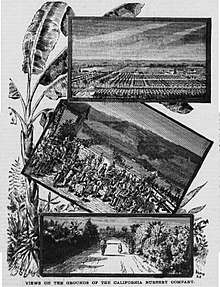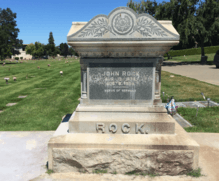John Rock (American nurseryman)
John Rock (August 19, 1836[2] (1838[3][4])-August 9, 1904)[2] was a German-born American horticulturalist and nurseryman. John Rock was a leader in California in pomology and the nursery business from 1865 until his death in 1904.[5] Charles Howard Shinn wrote the biography for John Rock in L.H. Bailey's Cyclopedia of Horticulture[6] He said "John Rock's scientific spirit, his wide and ever-increasing knowledge, his very high standards of business and his unselfishness made him during his long life the leader of Pacific coast nurserymen. He introduced more valuable plants and varieties to American horticulture than any other man of his period. His connection with Japan, India, Australia and with the great establishments abroad was close and constant. He did much to encourage men like Luther Burbank, and his collections were always at the service of students and the public."

Germany
John Rock was born in Germany - Lauter, Hesse,[3] or Hesse-Darmstadt.[3][4] Johann Fels may have been his birth name and he changed his name to John Rock when he came to the United States.[6] Another source says that his parents were named Roch.[2]
New York
John Rock immigrated to the United States when he was 15.[6] For a time he worked for various florists and nurseries,[6] [3]including Ellwanger & Barry[7] in Rochester, New York.
His passport in 1889 indicates that he immigrated to the United States aboard the William Tapscott from Liverpool in June 1857 and arrived in New York August 19, 1857.[4]
Civil War
John Rock enlisted in the 5th Regiment, New York Infantry on April 25, 1861,[8] (or April 11, 1861[3]) also known as Duryee's Zouaves. He served for two years and mustered out on May 14, 1863.
San Jose
After his discharge, John Rock headed to California by way of Panama. He arrived in San Francisco on June 19, 1863.[3] He settled in the Santa Clara Valley and may have first worked with James Lick. Rock was naturalized as an American citizen in 1864 in San Jose, California.[4]
Rock's Nurseries in San Jose
John Rock established his "Rock's Nurseries" along Coyote Creek in 1865. The first nursery was 48 acres on the Milpitas road. The nursery can be seen on Map 2 of the 1876 Thompson & West map.[9] His neighbor was pioneer nurseryman, B.S. Fox.
Around 1880, Rock moved to a location with 138 acres near Wayne Station on the Western Pacific line.[10][11] This nursery can be seen on "Part of Berryessa & Milpitas Districts Compiled for the Santa Clara Valley" in the Brainard Agricultural Atlas[12]
Rock continued to sell nursery stock through his "Rock's Nurseries" (at least until 1888) even after the California Nursery Company in Niles was established. The San Jose City Directory for 1887 has advertisements for both "Rock's Nurseries" and for the California Nursery Company.[13] He sold "Fruit & Ornamental Trees, Shrubs, Roses, Flowering Plants, Etc."
The California Nursery Company

The California Nursery Company was established and incorporated in 1884 in the town of Niles (now a district of Fremont, California). The 1886-87 descriptive catalog lists the officers. John Rock was President and R. D. Fox was Vice-president; The directors were John Rock, James Hutchison, R. D. Fox, Thos. Meherin, Wm. J. Landers. John Rock was the manager of the nursery.[15]
The California Nursery Company grew roses, ornamental trees and shrubs, and fruit and nut trees.
Fruit and Nut Trees
The 1902 catalog[16] describes the fruits and nuts that were grown in the nursery's specimen orchard shortly before Rock's death.
George C. Roeding bought the California Nursery Company 13 years after the death of John Rock in 1917. With this purchase, he gained a significant "test orchard" of fruit and nut trees. Roeding wrote about John Rock's "Mother Orchard" and his own specimen trees from his Fancher Creek nurseries in a 1926 publication, "Budwood, scions and cuttings : (embracing over 1000 varieties) from record performance fruit trees" [17] Rock's specimen orchard book from the late 1800s describes fruit varieties and where they were obtained. [18]
Figs
John Rock had the largest collection of figs on the Pacific Coast as reported by Gustav Eisen in 1901.[19] The figs came from Thomas Rivers & Son, from France, from the USDA (which had obtained the whole collection of the Royal Horticultural Society of London), and from local nurserymen.
Catalogs
Catalogs for the California Nursery Company can be found in these collections:
- Henry G. Gilbert Nursery and Seed Trade Catalog Collection[20] for USDA
- Mertz Digital Collections, New York Botanical Garden[21]
- The Biodiversity Heritage Library[22]
- The Internet Archive hosts many of these collections and has an Open Library interface.
Death

John Rock died in 1904. The 1904-1905 catalog[23] announces his death: "Our beloved Manager has passed into the Great Unknown. A familiar name and figure has gone-- a man and friend of sterling qualities is no more; one in whose judgement and abilities vast numbers of people and even governments have securely rested in horticultural matters can advise no longer. We mourn his loss". Rock is buried about 3 miles north of the California Nursery Company at the Chapel of the Chimes.[24]
John Rock was remembered by E.J. Wickson, at the 1911-1912 Pacific Coast Association of Nurserymen[25]: "He has gone to his reward, but his memory will always be honored by every nurseryman who ever knew him — Mr. John Rock, who began in this community in a small way and built up the nursery business and finally extended his interests into large commercial enterprises which I hope we shall visit while here. Mr. Rock has always stood to me as an example of what a nurseryman ought to be in his position as an educator to the community, because he possessed at the time when he was most active and energetic, a fuller and truer knowledge of the nursery business than any other man in California. He was a good student and possessed himself of all sources of information; he was a wonderful observer, and had a keen eye for a fruit or for a plant and, above all, had a sterling honesty and conscientiousness which led everyone who knew him to place implicit confidence in any statement which he might make, and you could trust Rock to give you facts, although it might not be immediately to his interest to do so. John Rock gave me a palm in 1879, a little palm in a pot, and I planted it in my garden in Berkeley, and that palm is today the handsomest and largest palm in the City of Berkeley — it must be 40 feet high and 30 feet across its branches. I see it every day that I am at home and never pass it without thinking that that palm stands as a monument to the life and service of John Rock in its community. It is stalwart, symmetrical and beautiful and sheds its beauty among all its environments; so Rock stood among the pioneer fruit growers and the more we know of his life and deeds the better we will be able to understand the possibilities of a nurseryman in the community."[26]
California Nursery Historical Park
The California Nursery continued on under other owners until the 1970s. The last 20 acres of the 463-acre nursery are a park in the Niles District of Fremont, California.[27] The archives of the California Nursery Company are in several locations: at the California Nursery Historical Park, managed by the Math Science Nucleus,[28] at the Fremont Main library, and at the Washington Township Museum of Local History.
References
- "Transaction and proceedings of the annual meeting. v.02 yr.1912". HathiTrust. Retrieved 2017-12-16.
- American Council of Learned Societies (1943). Dictionary of American biography. University of Illinois Urbana-Champaign. New York, C. Scribner's Sons.
- J. P. Munro-Fraser (1881). History of Santa Clara County, California. Harvard University. Alley, Bowen & co. pp. 736–737.
- Passport No. 2182, issued July 12, 1889 for travel to Heidelberg, Germany from July to October 1889.
- Wickson, Edward J. (Edward James) (1921). California nurserymen and the plant industry, 1850-1910. Cornell University Library. Los Angeles, Published by the California Association of Nurserymen. pp. 27.
- Bailey, L. H. (1917). The standard cyclopedia of horticulture :a discussion for the amateur, and the professional and commercial grower, of the kinds, characteristics and methods of cultivation of the species of plants grown in the regions of the United States and Canada for ornament, for fancy, for fruit and for vegetables; with keys to the natural families and genera, descriptions of the horticultural capabilities of the states and provinces and dependent islands, and sketches of eminent horticulturists /. hdl:2027/mdp.39015017880462.
- Nurserymen, American Association of (1922). Proceedings, Annual Convention American Association of Nurserymen. American Association of Nurseryman. p. 90.
- "Rosters of the New York Volunteers during the Civil War - Civil War Units from New York at the NY Military Museum and Veterans Research Center". dmna.ny.gov. Retrieved 2017-12-09.
- "Historical Atlas Map Of Santa Clara County, California. Compiled, Drawn And Published From Personal Examinations And Surveys By Thompson & West, San Francisco, Cala. 1876. Thos. Hunter Pr. Phil. N. Friend, Engr. Philad. C.L. Smith, Del [cartographic material]. in SearchWorks catalog". searchworks.stanford.edu. Retrieved 2018-01-02.
- Rock, John (1880). J. Rock's Descriptive Catalog of Fruits Cultivated and for Sale at Rock's Nurseries, San Jose, Cal. San Francisco: Francis, Valentine & Co.
- Foote, Horace S. (1888). Pen pictures from the garden of the world, or Santa Clara county, California. Allen County Public Library Genealogy Center. Chicago : The Lewis Pub. Co.
- "1880 Santa Clara County, Brainard Agricultural Atlas. :: Historic Map & Atlas Collection (SJPL California Room)". digitalcollections.sjlibrary.org. Retrieved 2018-01-04.
- "1887 San Jose City Directory :: San Jose City Directories - Business Classified Sections (SJPL California Room)". digitalcollections.sjlibrary.org. p. X, XX. Retrieved 2018-01-18.
- "Pacific Rural Press 14 April 1888 — California Digital Newspaper Collection". cdnc.ucr.edu. Retrieved 2017-12-16.
- Pacific Rural Press (27 November 1886). "Pacific Rural Press 27 November 1886 — California Digital Newspaper Collection". cdnc.ucr.edu. Retrieved 2017-12-10.
- California Nursery Co; Henry G. Gilbert Nursery and Seed Trade Catalog Collection (1902). Descriptive catalogue of fruit trees, small fruits, etc. National Agricultural Library U. S. Department of Agriculture. San Francisco, Calif. : Mysell-Rollins Company.
- California Nursery Co; Roeding, George Christian; Henry G. Gilbert Nursery and Seed Trade Catalog Collection (1924). Budwood, scions and cuttings : (embracing over 1000 varieties) from record performance fruit trees / supplied by the California Nursery Co. ; George C. Roeding, president. National Agricultural Library U. S. Department of Agriculture. Niles, Calif. : California Nursery Co.
- Rock, John (1887). California Nursery Ledger Book.
- Eisen, Gustavus A. (1901). The fig: its history, culture, and curing, with a descriptive catalogue of the known varieties of figs. LuEsther T. Mertz Library New York Botanical Garden. Washington, Govt. print. off. pp. 70–71.
- "Henry G. Gilbert Nursery and Seed Trade Catalog Collection : Free Texts : Download & Streaming : Internet Archive". archive.org. Retrieved 2018-01-03.
- "Nursery and Seed Catalogs". mertzdigital.nybg.org. Retrieved 2018-01-03.
- "California Nursery Co. - Biodiversity Heritage Library". www.biodiversitylibrary.org. Retrieved 2018-01-03.
- California Nursery Co; Landers, Wm J.; Henry G. Gilbert Nursery and Seed Trade Catalog Collection (1904). Catalogue and price-list. fruit and ornamental trees, evergreens, palms, roses, etc., 1904-1905. National Agricultural Library U. S. Department of Agriculture. Niles, Calif. : California Nursery Company.
- "John Rock (1836-1904) - Find A Grave Memorial". www.findagrave.com. Retrieved 2018-01-06.
- "Proceedings of ... annual meeting. 1911-12". HathiTrust. Retrieved 2019-10-02.
- "Proceedings of ... annual meeting. 1911-12". HathiTrust. Retrieved 2019-10-02.
- "Historical Parks & Facilities | City of Fremont Official Website". www.fremont.gov. Retrieved 2018-01-01.
- "california nursery historical park". www.msnucleus.org. Retrieved 2018-01-16.